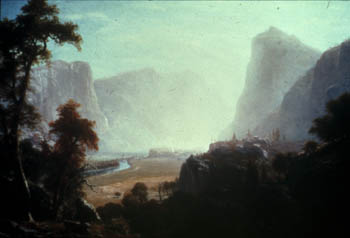![[Metroactive Arts]](/arts/gifs/art468.gif)
[ Arts Index | Silicon Valley | Metroactive Home | Archives ]
|
Buy the coffee-table art book 'Hudson River School: Masterworks from the Wadswroth Atheneum Museum of Art' at amazon.com. |

Lost World: The Hetch Hetchy Valley depicted in Alfred Bierstadt's 1874-1880 canvas has long since vanished beneath the waters of O'Shaughnessy Dam. Hudson's Hawkers Alfred Bierstadt and the Hudson River painters sold audiences not just pictures of America, but the idea of a new land By Michael S. Gant ALFRED BIERSTADT'S 1867 painting In the Mountains looks overdisplayed at the "Hudson River School" show at Stanford. The landscape occupies a wall by itself, framed by red-velvet drapes. One half expects an usher to materialize, discreetly pointing to a front-row seat. The presentation would not, however, jar the sensibilities of Bierstadt, a quintessential 19th-century American pictorial entrepreneur. Bierstadt sold the public more than just pictures of America's mountains, he sold them the "idea" of the American West. Working in a field first profitably plowed by Thomas Cole and Frederic Church, Bierstadt embarked on expeditions to remote realms and brought back "big pictures," just as great white hunters returned with big-game trophies. He exhibited the paintings--of majestic crags swirling with storm clouds--like blockbuster movies, under controlled lighting conditions with commemorative programs. That the pictures commanded prices as high as the peaks they depicted (New York magnate Le Grand Lockwood commissioned The Domes of the Yosemite for $25,000) only added to the hype. As did many an enterprise of the 1860s and '70s, Bierstadt's painting empire--and reputation--went bust, not to be revived for a hundred years. Looking at Bierstadt's landscapes (and those of his fellow Hudson River painters) now, it is necessary to clear some historical mists of our own: a century or more of art history that has preferred the figure over the landscape and a tradition that sees the West primarily through the sharply focused eyes of early photographers like Carlton Watkins and masters like Ansel Adams. Check In the Mountains again. What appears at first to be Yosemite Valley turns out to be a bit of legerdemain: that's El Capitan, sort of, on the left, but don't try to hit the trail head based on this painting. Bierstadt was aiming for an archetype, not a topo. He wanted to evoke for his Eastern audiences the awe that the first European visitors experienced when they encountered these natural cathedrals of granite. From our environmentalist era, Bierstadt's most poignant image is The Hetch-Hetchy Valley, California (1874-1880). A stone sentinel looms out of the haze; smoke rises from Indian fires in the distance. A minute figure takes in the panorama as if espying Sir Arthur Conan Doyle's Lost World--or maybe Jurassic Park. Dinosaurs might as well have roamed this valley, which is gone forever, inundated by the waters of O'Shaughnessy Dam in 1938. Bierstadt's Western vistas make the biggest impression of nearly three score paintings on display at Stanford. The term Hudson River School was applied late in the game to a group of mid-19th-century American landscape painters who loosely congregated in New York. One of the best concentrations of their works is held by the Wadsworth Atheneum Museum in Connecticut, the source for this show. But beyond trumpeting the natural wonders of the young nation--Niagara Falls, Yosemite, the Rockies--the Hudson River painters were a hard-to-pin-down bunch. As much as they marveled at the untrammeled (except by romanticized Indians) American wilderness, they also delighted in ruin-strewn Italy--especially America's first landscape king, Thomas Cole. Jasper Francis Cropsey savored cozy fall foliage with the gusto of a Norman Rockwell; Thomas Chambers' 1835 Niagara Falls shows some of the flattened perspective of folk art. Bierstadt's rival in the great-picture business, Frederic Church, roamed from the Bay of Fundy to the tropics. Asher B. Durand even painted the Hudson River itself. His 1851 View Toward the Hudson Valley, with two gentlemen walkers admiring a rustic valley, captures the equipoise between man and nature that man and nature never seem able to maintain.
Hudson River School shows through Jan. 18, 2004, at the Cantor Center for Visual Arts, Stanford University. (650.723.4177)
Send a letter to the editor about this story to letters@metronews.com. [ Silicon Valley | Metroactive Home | Archives ]
|
From the October 16-22, 2003 issue of Metro, Silicon Valley's Weekly Newspaper.
Copyright © Metro Publishing Inc. Metroactive is affiliated with the Boulevards Network.
For more information about the San Jose/Silicon Valley area, visit sanjose.com.